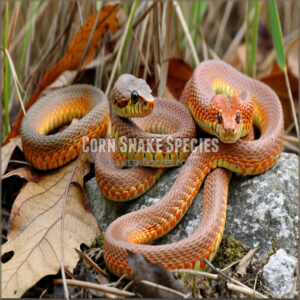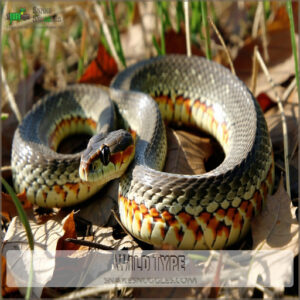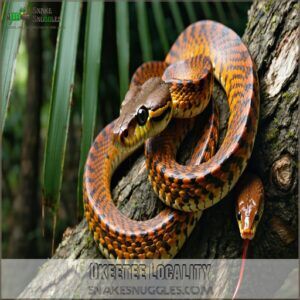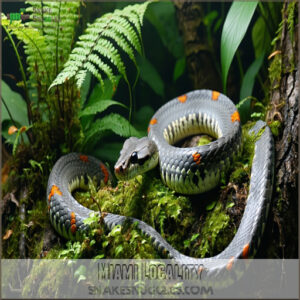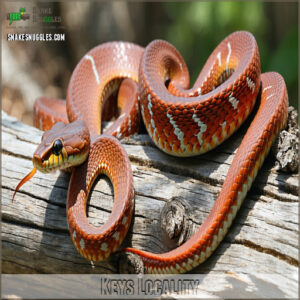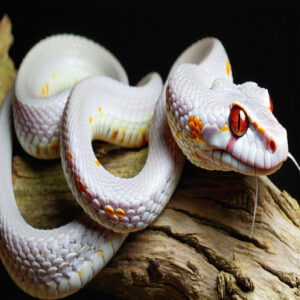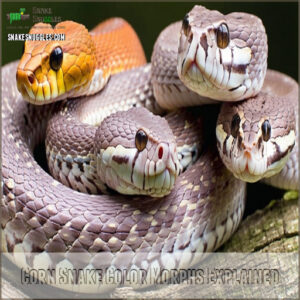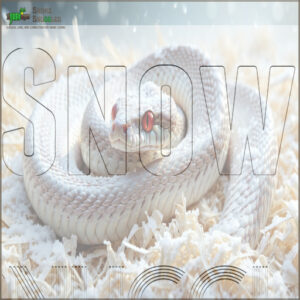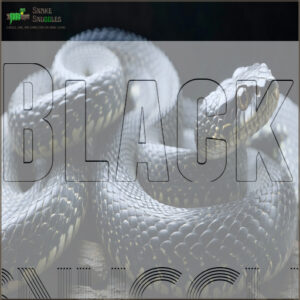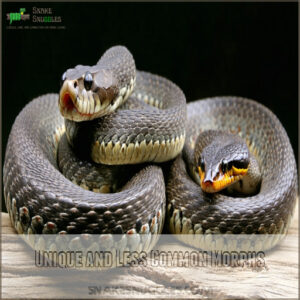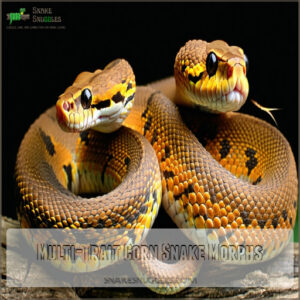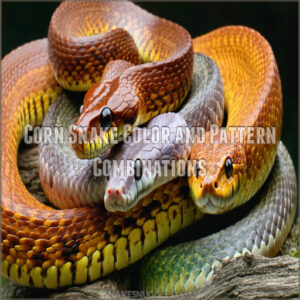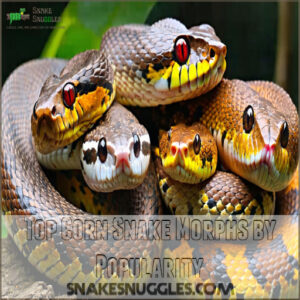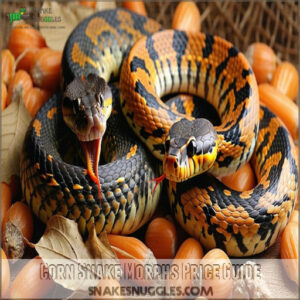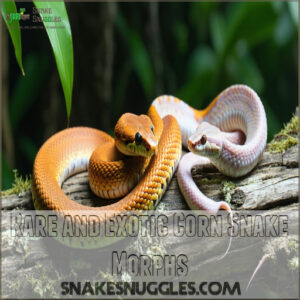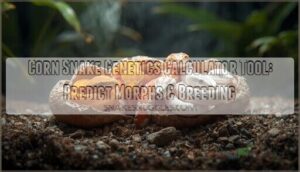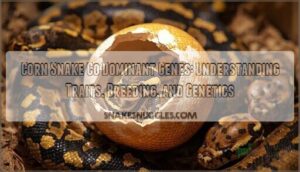This site is supported by our readers. We may earn a commission, at no cost to you, if you purchase through links.
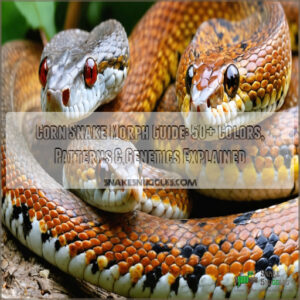
The wild type shows classic reddish-orange saddles on tan, while the Okeetee morph sports vivid copper and orange.
Miami Phase morphs dazzle with silver bases and burnt orange blotches.
Albinos lack dark pigments, showing off reds, whites, and yellows with ruby eyes.
Whether you’re drawn to the Carolina’s vibrant orange saddles or the Great Plains’ unique purplish-gray patterns, there’s a morph that’ll catch your eye.
These gentle creatures make perfect pets, and their genetics hold fascinating secrets that shape their remarkable variety.
Table Of Contents
- Key Takeaways
- Corn Snake Species
- Common Corn Snake Colors
- Corn Snake Color Morphs Explained
- Popular Corn Snake Morphs
- Unique and Less Common Morphs
- Multi-Trait Corn Snake Morphs
- Corn Snake Color and Pattern Combinations
- Top Corn Snake Morphs by Popularity
- Corn Snake Morphs Price Guide
- Rare and Exotic Corn Snake Morphs
- Frequently Asked Questions (FAQs)
- What are the best corn snake color morphs?
- What does a corn snake morph look like?
- How many types of corn snake morphs are there?
- What is a stripe corn snake morph?
- Are corn snake morphs good?
- Where can I find cornsnake morphs?
- What is the rarest corn snake morph?
- What are the colors of corn snakes morphs?
- How big do corn snake morphs get?
- What is a healthy corn snake shape?
- Conclusion
Key Takeaways
- You’ll find over 800 corn snake morphs, ranging from common varieties under $100 to rare genetics worth over $1,000, with popular choices including Lavender, Snow, Palmetto, and Albino morphs.
- Your corn snake’s appearance comes from genetic mutations and selective breeding, combining traits like amelanistic (no black pigment), anerythristic (no red pigment), and hypomelanistic (reduced black pigment).
- You can spot multi-trait morphs through distinct features like the Aztec’s maze-like patterns, Tessera’s twisting designs, or Charcoal’s gunmetal-gray base with dark patterns.
- You’ll need to consider both genetics and price points when choosing a morph – affordable options like Normal ($30-50) and Amelanistic ($45-75) make great starter pets, while investment-grade morphs like Scaleless Palmetto can cost thousands.
Corn Snake Species
Corn snakes belong to a handful of distinct subspecies, each with unique features and natural ranges. These include the Carolina corn snake, Great Plains rat snake, and Slowinski’s corn snake.
Carolina Corn Snake
The Carolina corn snake is a dazzling staple of corn snake morphs, prized by enthusiasts.
Its vibrant orange saddles on a tan background make it visually striking. These snakes typically grow between 2 and 6 feet, thriving in captivity for over 20 years.
Here’s why they’re fascinating:
- Adaptable nature aiding habitat conservation
- Morph genetics highlighting stunning color patterns
- Docile snake behavior perfect for beginners
Dive into Carolina corn snakes, and explore endless corn snake variations!
Great Plains Rat Snake
Shifting to another fascinating species, the Great Plains Rat Snake stands out with its white body and purplish-gray saddles.
Found across Colorado, Texas, and Mexico, this species thrives in semi-arid habitats. Typically 3-5 feet long, they’re also called mouse snakes due to their diet.
Enthusiasts value them for their unique appearance and a role in snake hybrids.
Check out key details below:
| Feature | Details | Significance |
|---|---|---|
| Appearance | White with gray saddles | Stands out among snake morphs |
| Habitat | Dry, semi-arid regions | Adapted to habitat loss |
| Breeding Use | Snake hybrids, research | Advances corn snake genetics |
Slowinski’s Corn Snake
The Slowinski’s corn snake, a fascinating relative within corn snake morphs, thrives in eastern Texas, Arkansas, and Louisiana.
Preferring dry, rocky areas, this species displays gray patterns with deep maroon saddles and distinctive spearhead markings on its head.
Their adaptability extends to various environments, like wooded groves, rocky terrains, or even suburban backyards.
Though not prominent in the pet trade, Slowinski’s morph captivates herpetology enthusiasts.
This species contributes substantially to understanding corn snake genetics and breeding.
For enthusiasts, their snake habitat underscores the importance of conserving the Slowinaki corn snake range.
Common Corn Snake Colors
You’ll find corn snakes in a variety of natural colors, each unique and beautiful. Common colors include red, orange, yellow, and brown.
Wild Type
The wild type, or Normal Morph, is where corn snake morphs begin.
Its earth tones and base patterns feature a tan body with reddish-orange saddles outlined in black. These snakes thrive in natural habitats like forests, fields, and barns.
Their natural variations make them stunning in their simplicity. They’re known for their calm temperament, and are beginner-friendly and essential in corn snake genetics.
If you appreciate classic beauty and reliability, the wild type is an excellent choice for corn snake care.
Okeetee Locality
The Okeetee corn snake, originating from its namesake Okeetee Habitat in South Carolina, is one of the most striking snake morphs you’ll encounter.
Its bold color patterns feature vivid reddish-orange blotches surrounded by thick black borders, all set against a deep copper background.
This distinctive look makes the Okeetee a favorite among enthusiasts exploring the corn snake morphs guide.
- Why it stands out:
- Thrives in South Carolina’s specific climate and landscape.
- Reverse Okeetee morphs showcase brighter tones with reduced black borders.
- Its locality genetics give it timeless appeal for breeders.
Whether you prefer the classic Okeetee or Reverse Okeetee morphs, these snakes showcase nature’s artistry.
Their geographic range links them closely to Palmetto corn snake origins.
Miami Locality
The Miami Phase corn snake is one of the standout Florida morphs, celebrated for its silver base and vivid burnt orange blotches.
Hailing from sunny South Florida, this eye-catching miami morph is an excellent example of striking corn snake genetics.
With its light gray tones and distinctive patterns, the Miami corn snake offers a unique aesthetic, making it a perfect choice for enthusiasts, these docile beauties typically grow between 3-5 feet.
Making them manageable, stunning pets.
Keys Locality
The Keys Locality corn snake, often called the Rosy Ratsnake, is a beautiful native of the Florida Keys.
It’s a great example of how corn snake genetics reflect regional habitats. You’ll notice its reddish-orange body and light cream-colored belly, which make it stand out.
These Florida snakes are an exciting addition for collectors who love unique regional morphs.
- Bright red-orange body with gray undertones
- Deep red saddle markings
- Creamy belly with checker patterns
- Distinct head pattern unique to island genetics
- Adapted to Keys habitat and tropical conditions
Albino
Albino corn snakes captivate with their vivid colors and melanin deficit.
Albinism removes dark pigments, leaving reds, whites, and yellows.
Their ruby-red eyes highlight eye sensitivity, needing soft lighting.
Body colors range from white to yellow, often adorned with pink or orange saddles.
Check an albino corn snake color chart for variety.
Their leucistic traits make them stand out, offering gentle, docile temperaments perfect for beginners.
If you’re considering adding an albino corn snake, you’ll find plenty to compare and buy in Toronto.
Corn Snake Color Morphs Explained
Corn snake color morphs come from genetic mutations and selective breeding, creating endless variations in color and patterns.
You’ll find morphs influenced by recessive traits and codominant genes, making each one unique.
Genetic Mutations
Genetic mutations are the key to corn snakes’ incredible diversity, altering their DNA variance to create jaw-dropping traits.
These gene expressions affect pigmentation and patterns, shaping the snake’s stunning appearance. Each mutation reveals a unique palette in snake genetics.
- Amelanistic: Removes all black pigment, leaving vivid reds and whites.
- Anerythristic: Lacks red pigment, producing silvery-blue tones.
- Axanthic: Eliminates yellow pigment, resulting in gray and white appearance.
- Hypomelanistic: Reduces black pigment, giving softer, muted traits.
Understanding reptile genetics makes morph identification easier.
Selective Breeding
Selective breeding in corn snake breeding is like crafting art through nature.
By pairing snakes with specific traits, you can discover stunning color morphs and patterns. Start by identifying desirable features using morph identification and breeding techniques.
Combine strong genetic testing with healthy parent snakes to protect genetic diversity. Snake genetics, hybridization methods, and understanding trait inheritance are your tools for success.
Focus on long-term planning to create breathtaking results while preserving robust, healthy lines for future generations, which is crucial for maintaining genetic diversity.
Recessive Traits
Recessive traits in corn snakes, like Amel Genetics (albino) or Anery Traits (anerythristic), rely on precise gene expression.
Both parents must carry and pass on these hidden genes for the trait to show. Understanding recessive inheritance is vital for breeding snakes with vivid Hypo Morphs or rare traits, such as scaleless.
- Traits result from specific gene pairs.
- Two carriers guarantee the morph.
- Common examples: amelanistic and hypomelanistic.
- Careful pairing guarantees desired results.
Codominant Genes
Codominant genes in corn snake genetics allow both gene versions to influence a snake’s appearance, creating stunning morphs through visible trait expression.
Think of it like blending colors—each parent contributes, and you see both in the offspring. These gene interactions produce unique snake color morphs, often more intricate than single-gene patterns.
For example, codominant effects create remarkable morphs like Pewter, where hypo and charcoal traits merge beautifully. This genetic variance opens exciting possibilities in corn snake breeding, adding layers of complexity to inheritance patterns.
Understanding codominant genes helps you predict patterns and explore creative combinations in creating breathtaking corn snake morphs effortlessly, which is key to corn snake breeding and leads to unique snake color morphs with intricate patterns.
Popular Corn Snake Morphs
You’ll find some of the most striking corn snake morphs in this section, like Lavender, Snow, Black, and Palmetto.
These morphs showcase incredible variety in color, pattern, and genetic traits.
Lavender
The lavender corn snake is a favorite among enthusiasts for its subtle purple-gray tones that set it apart.
Its lack of red pigments creates striking, muted color patterns, making these snakes both unique and mesmerizing.
Bred from anerythristic genetics, they’re a mid-range morph priced around $150-300.
- Striking Traits: Purple-gray hues with soft lavender motley patterns.
- Genetics: Linked to anerythrism and selective morph breeding.
- Adaptability: Lavender corn snake adaptations make them easy for pet ownership.
- Variants: Includes hypermelanistic lavender and lavender ghost morphs.
- Care Requirements: Lavender care isn’t overly complex—ideal for beginners.
Snow
Snow morphs are mesmerizing white snakes with a frosty elegance that’s hard to miss.
Their bodies resemble freshly fallen snow, accented by glowing ruby-red eyes. Featuring “Frozen Genetics,” this morph results from combining amelanistic and anerythristic traits, completely removing black and red pigments.
Often admired for their “Winter Colors” and gentle personalities, Snow morphs suit beginners and seasoned keepers alike. They’re wallet-friendly, with prices ranging from $100-200.
Closely related varieties like coral snow morph and strawberry snow add extra flair, making Snow morphs a top choice for reptile enthusiasts, offering a unique combination of frosty elegance and gentle personalities.
Black
With dramatic looks, black morph corn snakes, often called shadow morphs, captivate enthusiasts.
These stunning snakes showcase pure melanistic traits, distinct from albino corn snakes. Many different corn snake morphs exist.
Their dark patterns vary, resembling living shadows or faint obsidian designs.
- Black Genetics enhance melanin’s role, creating their rich appearance.
- Scales shimmer, giving them a charcoal glow.
- Dark patterns draw a stark contrast to vibrant corn snake morphs, enhancing diversity in collections.
Palmetto
If you’re intrigued by striking patterns, the Palmetto corn snake deserves your attention.
These snakes boast brilliant white bodies adorned with scattered spots, resembling a starry night sky—a breathtaking morph to behold.
The secret behind this beauty lies in Palmetto Genetics, a recessive trait requiring both parents to carry it.
Rare and sought after, these Palmetto Morphs cost between $800 and $2,000, making them an investment-grade addition.
Whether you’re exploring Palmetto Breeding or admiring a Scaleless Palmetto, this standout shines in any corn snake morphs guide.
Unique and Less Common Morphs
You’ll find some of the most fascinating and rare traits in unique and less common corn snake morphs.
These stunning varieties, like Cinder and Kastanie, offer distinctive patterns and colors worth exploring.
Cinder
The Cinder corn snake stands out with muted colors, a smoky gray base, and a signature dovetail design.
Its faded blotches lack bright pigments, emphasizing its unique genetic expression.
In your corn snake morph identification, note this recessive trait requires both parents to carry the gene.
Regarded as rare, these corn snake morphs guide enthusiasts with their distinct Cinder patterns, creating an unforgettable addition to any collection.
Diffused
Diffused corn snake morphs stand out with their faded patterns and blotch fading, giving them a soft, blended look.
These snakes lack defined edges between markings, creating a watercolor-like effect.
Popular variations like diffused tessera and diffused snow showcase fascinating pattern reduction and color dilution.
Understanding their morph genetics helps with proper corn snake morph identification, making these stunning snakes a collector’s favorite.
Dilute
The Dilute corn snake morph stands out with its softly faded hues, offering a subtle twist to classic corn snake colors.
This trait, linked to genetic dilution, gives their appearance a washed-out elegance, reminiscent of lavender tones or hypomelanistic palettes.
These dilute colors emphasize natural beauty without bold patterns.
Breeding for this rare morph expression requires care, but it showcases unique morph inheritance in corn snake morphs, perfect for enthusiasts valuing understated charm, and the result is a display of unique morph inheritance.
Hypomelanistic
Hypomelanistic corn snake morphs, or "hypos," captivate with their striking melanin reduction.
This genetic trait boosts color variation, making reds, oranges, and yellows more vibrant.
Explore various corn snake morph genetics to understand inheritance patterns.
Patterns remain intact but appear softer and more expressive.
As a recessive trait, Hypo genetics require both parents to carry it for success.
Perfect for enthusiasts, this corn snake morph showcases stunning pattern expression, making it a favorite in any detailed corn snake morphs guide on snake genetics.
Kastanie
Kastanie corn snakes stand out in the domain of corn snake morphs with their warm, earthy tones.
These rare variants highlight the intricacy of corn snake genetics and are adored by enthusiasts.
Their unique features include:
- Deep chestnut base color that exudes richness.
- Dark coffee-brown saddle markings, creating striking contrast.
- Golden highlights along the sides, adding warmth and depth.
- Amber eyes that glow with a soft warmth.
If you’re diving into corn snake morphs, Kastanie is a must-see in any corn snake morphs guide.
Their beauty justifies their rarity and demand in breeding programs.
Multi-Trait Corn Snake Morphs
Multi-trait corn snake morphs combine multiple genetic traits to create truly unique patterns and colors. These combinations, like Aztec or Caramel, showcase endless possibilities.
Aztec
The Aztec morph stands out in the domain of corn snake morphs with its intricate, maze-like patterns resembling ancient Aztec art.
This mesmerizing mix of Motley and Stripe traits creates one of the most striking designs you’ll find in corn snake pattern and color variations.
Perfect for collectors or breeders, its unique Aztec patterns offer stunning visuals and fascinating Morph Breeding possibilities.
Looking for unforgettable scale traits and a strong genetic foundation? The Aztec morph fits beautifully into any collection.
As popularity grows, you’ll find this gem highlighted in corn snake morphs guides like the detailed Corn Snake Morphs Guide 2024, offering a valuable resource for those interested in the unique Aztec morph.
Charcoal
From the smoky allure of Aztec, step into the shadowy beauty of the Charcoal morph. These snake morphs feature a stunning gunmetal-gray base with dark patterns that mesmerize any enthusiast.
Charcoal genetics are a favorite, offering endless possibilities in breeding techniques.
- Rich Color Variations: Shades of gray blend beautifully into subtle patterns.
- Unique Combinations: Pairs well with diffused tessera or sunkissed morph genetics.
- Versatile Breeding Potential: A prized gene for creating sunkissed charcoal cornsnakes.
Tessera
The Tessera morph is a fan-favorite for corn snake enthusiasts due to its standout maze-like patterns.
Unlike typical blotched designs, Tessera patterns twist and turn, creating a truly artistic look.
With varied colors, these snakes shine in breeding techniques and showcase exciting color combinations.
Tessera morph genetics also pair well with other morphs, allowing breeders to reveal endless possibilities.
Featuring a smoother, more linear pattern, the tessera corn snake adds elegance to collections with unique scale variations and tessera motley ventrum.
Caramel
Caramel morph corn snakes glow with buttery-amber hues, a result of unique Caramel Genetics.
Their Color Variations range from light tan to golden brown, with soft saddle markings creating a dreamy look.
Perfect for Morph Breeding enthusiasts, these snakes pair beautifully with lavender morphs or bold patterns like caramel motley or caramel stripe.
Refer to a corn snake morphs guide for creative genetic pairings and size insights.
Corn Snake Color and Pattern Combinations
Corn snake color and pattern combinations offer endless possibilities, from solid shades to intricate designs. These unique traits come from selective breeding and genetics.
Solid Colors
Solid color corn snakes are true works of art.
With consistent Red Tones, deep Black Scales, or pale White Morphs, these snakes emphasize the magic of Color Genetics.
Popular options like the lavender corn snake, caramel corn snake, or albino corn snake showcase vibrant hues.
Anerythristic corn snakes, with their muted tones, and sunkissed corn snakes, with warm shades, are favorites.
These Solid Patterns illustrate selective breeding’s potential, making them sought-after gems for collectors, highlighting the beauty of selective breeding.
Patterned Morphs
Patterns bring corn snakes to life, offering eye-catching combinations that stand out.
These variations, like the motley pattern or striped pattern, create some truly stunning appearances.
You’ll notice features like:
- Zipper patterns, resembling a zigzag running down the spine.
- Banded morphs, with distinct crossbands that add symmetry.
- Blotched types, showcasing bold, irregular spots.
Patterns aren’t just random; they result from specific genetics carefully bred by experts.
Morphs like motley, striped, and banded often make these snakes collector favorites.
Multi-Trait Combinations
When diving into multi-trait combinations, corn snake morphs reveal fascinating possibilities.
From stunning color combinations to intricate pattern mixing, each snake tells a story of genetic blending.
Whether it’s a Lavender Tessera with Caramel accents or a Snow Motley enhanced by Charcoal, the outcomes are unique.
Use this quick morph guide to explore trait interactions:
| Trait Combo | Color Features | Pattern Highlights |
|---|---|---|
| Lavender Tessera | Soft pink hues | Striped pattern |
| Snow Motley | White with subtle gray | Speckled blotches |
| Charcoal Tessera | Muted tones of gray | Sharp-lined stripes |
Top Corn Snake Morphs by Popularity
If you’re looking for the most popular corn snake morphs, some stand out for their stunning colors and unique traits.
These morphs combine beauty with genetics, making them favorites among collectors and hobbyists.
Top 10 Corn Snake Morphs
Every snake enthusiast loves the beauty and variety of corn snake morphs, and these top 10 are no exception.
They’re admired for their stunning color patterns, genetic uniqueness, and wide appeal. Many popular morphs are highlighted in this corn snake morph guide.
Here’s why they shine:
- Morph Classification: Each features distinct traits, from glittering Albinos to mesmerizing Palmettos.
- Snake Genetics: Careful breeding enhances their vibrant corn snake colors and fascinating snake morphs.
- Breeding Tips: High demand makes these stars perfect for breeders passionate about Snake Genetics.
Explore their charm in this corn snake morph guide!
Top 20 Corn Snake Morphs
The top 20 corn snake morphs highlight incredible diversity with stunning color patterns and genetic traits.
Classic options like Okeetee and Miami Phase meet bolder styles like Lavender and Palmetto.
This curated corn snake morph guide celebrates unmatched beauty and uniqueness, aiding enthusiasts in exploring morph pricing and breeding potential.
Whether valuing rarity or appearance, these morphs offer endless possibilities for anyone mastering snake genetics and corn snake colors.
Emerging Trends
The universe of corn snake morphs keeps evolving.
Snake genetics now push boundaries with gene editing tech on the horizon, promising wilder patterns than ever before.
Amelanistic, axanthic, and anerythristic mutations affect pigment production. You’ll find ethical breeding practices gaining momentum, focusing on both health and stunning looks.
The Scaleless morph leads rare finds, while Palmetto and Paradox morphs stay scarce.
For the ultimate collection showpiece, watch for Banana Pied and Scaleless Lavender morphs – they’re among today’s most coveted trending colors.
Explore this informative corn snake morph guide.
Corn Snake Morphs Price Guide
You’ll find corn snake morphs at every price point, from common varieties under $100 to rare genetics worth over $1000.
Whether you’re starting with a basic morph or investing in a premium variant like the Scaleless, this guide will help you understand current market prices.
Affordable Morphs
Starting your corn snake journey doesn’t have to drain your wallet. Budget-friendly morphs offer beautiful colors and patterns at entry-level prices. You’ll find several affordable options that make great starter pets.
Many breeders specialize in affordable corn snake morphs. Here are some low-cost morphs that deliver stunning looks:
- Normal (Wild Type): Classic orange with red saddles, priced at $30-50
- Amelanistic: Beautiful white and red patterns, available for $45-75
- Anerythristic: Gray-scale beauty without red pigments, costs $50-80
- Motley: Unique striped pattern, typically $60-90
These cheap morphs give you the same joy of corn snake ownership as their pricier relatives. They’re perfect for new keepers or those watching their budget. Plus, many breeders offer package deals that include basic care supplies with your purchase.
Mid-Range Morphs
While basic morphs offer great value, mid-range corn snake morphs present stunning visuals at reasonable prices.
These special patterns typically cost between $100-$300, offering unique genetic traits and eye-catching colors.
Price Range Popularity
These morphs combine beautiful color patterns with proven snake genetics, making them perfect for both new collectors and experienced breeders.
High-End Morphs
High-end corn snake morphs represent the pinnacle of reptile breeding excellence.
Scaleless snakes and Lavender morphs showcase unique patterns that command prices upward of $1,000. You can compare current scaleless corn snake prices.
The rarest breed of corn snake, the Palmetto, features striking white scales with scattered dark spots. These exceptional specimens result from selective high-end breeding programs that perfect rare genetics over multiple generations.
For collectors, they’re living works of art worth the investment.
Investment-Grade Morphs
Beyond premium morphs, you’ll find corn snake morphs that serve as true investments.
The Scaleless Palmetto tops the list, combining ultra-rare genetics with stunning visuals.
For prospective owners, scaleless palmetto corn snake products are readily available.
Smart collectors focus on proven breeding pairs of rare morphs like Kastanie and Charcoal combinations.
Market trends show growing demand for unique genetic traits, especially in multi-trait morphs.
When valuing investment-grade specimens, look beyond price tags to breeding potential, genetic purity, and established bloodlines.
Rare and Exotic Corn Snake Morphs
You’ll find rare corn snake morphs like Scaleless and Miami Phase can cost hundreds of dollars due to their unique genetics and limited availability.
These exclusive morphs come from specialized breeding programs that combine specific genetic traits to create stunning patterns like the pure white Blizzard or the striking Ghost morph.
Limited Edition Morphs
Limited edition corn snake morphs represent the pinnacle of selective breeding.
You’ll find remarkable specimens like the scaleless lava and blizzard morph commanding top dollar in the market.
The lavender motley and sunkissed charcoal showcase nature’s artistic potential through careful genetic selection.
Many morphs involve interspecies hybrid breeding.
These rare hybrids often emerge from years of precise morph genetics work, making them highly sought after.
The candy cane morph, with its striking red and white pattern, exemplifies these unique patterns.
While prices reflect their exclusivity, these limited breeding success stories offer dedicated keepers a chance to own truly exceptional specimens.
High-End Breeding Programs
Elite breeding programs take corn snake genetics to new heights, blending science and artistry.
Seasoned breeders spend decades perfecting their craft through careful morph selection and genetic testing.
Understanding corn snake morph genetics is essential for creating new variations.
These dedicated professionals create stunning varieties through:
- Advanced breeding techniques that push genetic boundaries
- Sophisticated program management tracking multiple generations
- Extensive breeder networks sharing rare morphs
- Cutting-edge genetic testing to verify traits.
You’ll find their prized specimens at top expos, where collectors enthusiastically invest in these living masterpieces.
Each snake represents years of careful planning and precise genetic work.
Unique Genetic Combinations
While top breeders perfect their craft, an exciting domain of genetic combinations has emerged.
You’ll discover remarkable corn snake morphs that blend multiple genetic traits into stunning new varieties.
These trait inheritance patterns create unique color genetics that showcase the incredible diversity possible through careful hybrid breeding, which is a result of genetic combinations.
Frequently Asked Questions (FAQs)
What are the best corn snake color morphs?
You’ll love the Lavender morph’s pink base and gentle blotching, or try the striking Snow morph’s white beauty.
The Palmetto’s random splashes of color and the dramatic Blood Red morph are stunning choices too.
What does a corn snake morph look like?
Picture a snake that’s like a living canvas – you’ll see striking patterns and colors ranging from fiery oranges to cool blues.
Each morph has unique blotches, stripes, or solid colors defining its appearance.
How many types of corn snake morphs are there?
You’ll find over 800 recognized corn snake morphs today, with 5 wild-type and 28 genetic strains serving as the foundation. That’s over 500 million possible combinations when breeding these beautiful reptiles.
What is a stripe corn snake morph?
A stripe morph displays a continuous band running down your snake’s back instead of the typical blotched pattern.
You’ll notice this distinct genetic trait creates an elegant, unbroken line along the body.
Are corn snake morphs good?
You’ll get amazing variety with corn snake morphs.
They let you choose unique colors and patterns while keeping the same gentle temperament.
Plus, each morph gives your snake a distinct personality and appeal.
Where can I find cornsnake morphs?
You’ll discover corn snake morphs at specialized reptile breeders, local pet stores, and reptile expos. Online marketplaces like MorphMarket also offer a wide selection of unique morphs for your collection.
What is the rarest corn snake morph?
Among over 800 recognized corn snake morphs, the Scaleless morph stands as the rarest.
You’ll find this unique hybrid, bred from Great Plains Rat Snake genetics, commanding prices around $500 in today’s market.
What are the colors of corn snakes morphs?
You’ll find corn snake morphs in stunning shades of orange, red, brown, yellow, white, gray, pink, and blue.
Each morph’s unique pattern combines these colors for beautiful variations you can’t resist.
How big do corn snake morphs get?
Your corn snake will typically grow between 2 to 5 feet long, regardless of its morph type.
Don’t worry about color variations affecting size – they’ll reach the same length as regular corn snakes.
What is a healthy corn snake shape?
Like a perfectly shaped cucumber, your snake should be smoothly rounded from head to tail.
You’ll want a consistent girth without bulges or dents.
They shouldn’t be too thin or fat.
Conclusion
Whether you’re drawn to fiery oranges or cool silvers, choosing your perfect corn snake morph is an exciting journey.
You’ll find endless possibilities in this detailed corn snake morph guide, from classic wild types to rare designer combinations.
The science behind these stunning variations adds another layer of fascination, and each morph has unique care needs and price points.
With proper research and preparation, you’ll soon welcome home a corn snake whose colors and patterns perfectly match your vision.

